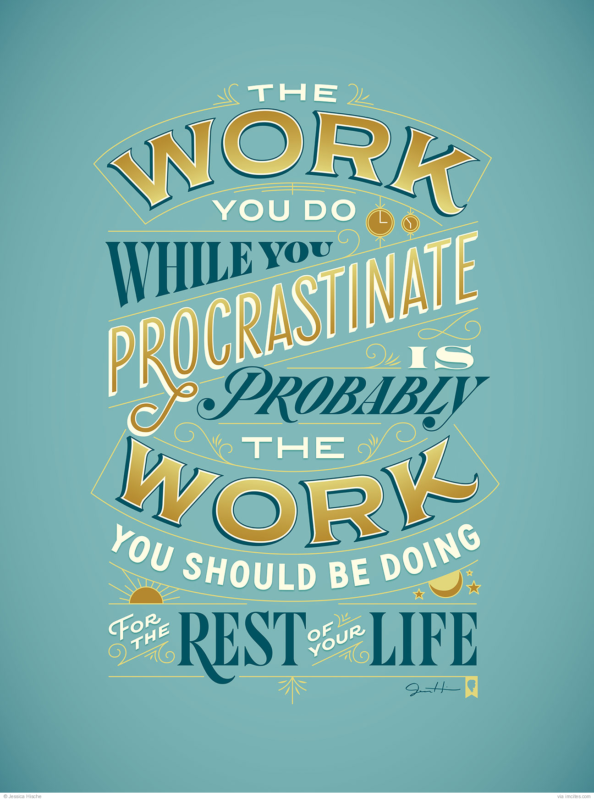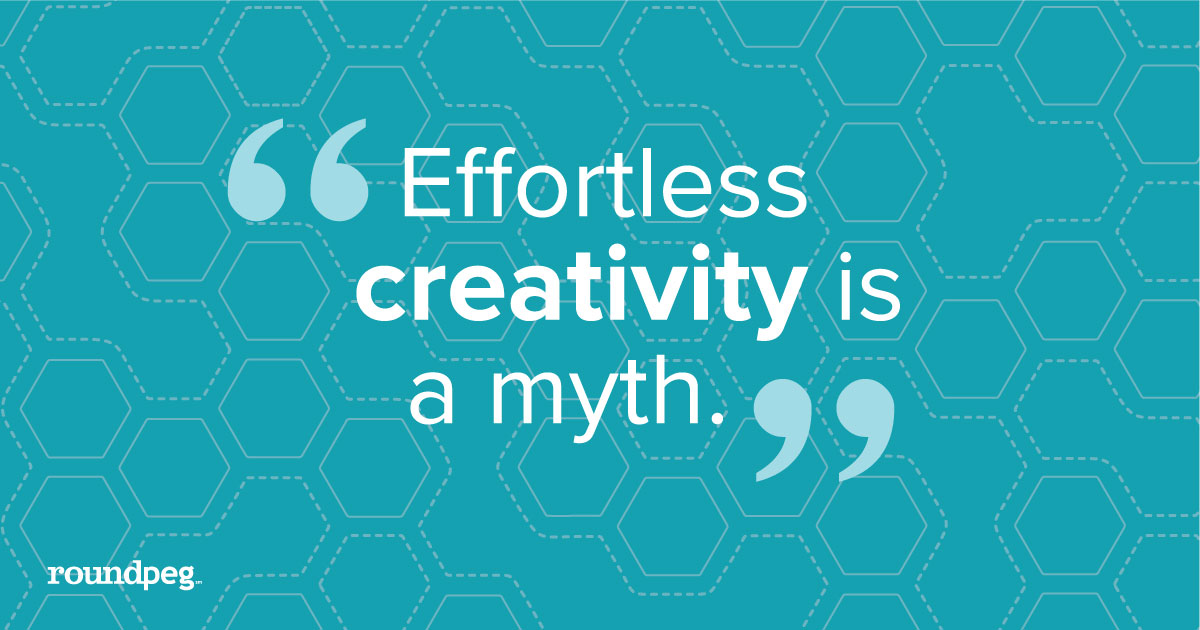Effortless creativity is a myth.
I had an assignment in middle school where we were instructed to envision our future as an adult and schedule a work week accordingly. At that time I intended to write (about what was still vague, which is probably why I’m a designer). My days were uninhibited by administrative tasks that plague any agency, let alone a freelancer as I dreamed and allowed for sprawling caverns of writing time. Each day was punctuated with a trip to Panera for lunch because I had no concept of a budget. Apparently the soup-and-sandwich deal is all I required for creative inspiration and lifelong happiness.
If we’re honest with ourselves, that’s essentially how we view The Creative Life. No hounding deadlines. No creative block during said deadlines. No worries about the the bills that would be paid with the assignment that’s due tomorrow and you’re plum out of ideas.
Sounds like a…job, doesn’t it? And like any job, you have to maintain the right perspective, stay interested and collaborate with other people to make great work.
Find Your Must
There’s an abundance of quotes I could pull from about keeping perspective, but one that has made the rounds somewhat recently is from letterer Jessica Hische: “The work you do while you procrastinate is probably the work you should be doing for the rest of your life.”

You’re probably thinking “why would I be working when I’m trying not to work?” (at least that’s what first crossed my mind). But that’s it. You can’t help it. It’s what you’re passionate about. When you are doing it you genuinely don’t notice time passing because you’re engrossed with what you’re doing. It could be something as mundane as organizing files that gets your OCD heart all aflutter or as multi-dimensional as planning, preparing and hosting exquisite meals. You’d do it all the time if you could.
So why don’t you?
It’s scary. It’s what Jessica refers to as “procrastiworking” Elle Luna calls your “must” (that piece is excellent, you should probably read it). The thing you dream of doing if you weren’t at your current job, if you didn’t have to pay off that student loan or have a car payment, if other people weren’t dependent on you. Why’s it scary? More often than not, your “must” doesn’t have a clear-cut way of providing income, otherwise you’d be doing it already.
That’s what makes “must” so tantalizing. It often requires a leap into the unknown. Yet if you “must” do it, what’s the risk of never making that jump? Will you look back on your life and be content knowing you never took the risk?
I believe this “must” is an ingredient of creativity. So many professionals who rely on creativity to produce income do so because they genuinely don’t know what they’d do otherwise. It’s not as if they got into the game because they knew they were promised vast sums of money or widespread notoriety if they worked hard enough. “Starving artist” is an unfortunate stereotype for a reason. They’re creative for a living because they have to be.
Sometimes there’s not much of a choice because the leap is genuinely too far. You want to make money selling paintings but have never sold one in your life. You need a different kind of degree to get a job that suits your interests better. Suggesting you throw caution to the wind and go hard after your dreams is downright foolish. When you can’t take a big jumps, small steps are still moving in the direction of your goal rather than not moving at all. Instead of quitting your job with the intent of providing for yourself with your art, carve out a few hours a week to paint. Take an online class towards the degree you want. It sounds so trite and simple, and it’s not. It’s hard work. But like I said, what happens if you don’t?
Once you discover the thing you absolutely must do, your perspective changes. Either you’re taking steps towards achieving your “must,” or you’re actively trying to figure out what that is. If you’ve narrowed your focus, priorities and perspective become clearer.
Perhaps you’ve found your “must” and are taking steps to achieving it. In less elevated terms, “procrastiworking” and the “must” are bolstered by passion, a notoriously fleeting commodity. If you’re lucky enough to recognize a sustainable passion, what do you do on days it’s just not there?

Stay Interested
You did your part. You showed up. Your passion did not. Maybe you’ve been working on a project for the past several hours or days or even months and you’ve got nothing.
From what I’ve experienced and read, the best way to work on something when you have no ideas is to not work on it at all. Which makes absolutely no sense, until you try it.
I’ve read from several professional creatives I admire they had to rid themselves of the tendency to push harder when they were struggling for ideas because it genuinely wasted time and didn’t produce work they were proud of.
When working is negatively productive, what do you do? Anything else. It could even be tangential to your business or practice. A designer I follow posted a quick little ukulele jam while he was waiting for files from a client. That mental break activated a different part of his brain, giving what he was focusing on a rest.
Read an interesting article. Go for a walk. Anything else.
It’s helpful if you’re interested in other things than your main passion. David Ogilvy said “if you want to be interesting, be interested.” When you’re looking for inspiration, it’s amazing how something completely unrelated will spark an idea for a project you’re stuck on.
Personal projects are also a great way to exercise creative muscles. Sometimes deadlines provide the ultimate creative inspiration and let you know when your work is done, but clients tend to have opinions that are different from your original vision. What would you do or make if it’s just for you? And just like external inspiration, ideas and skills learned working on personal projects often translate to client work, sometimes when you least expect it.
One of the best ways to get better ideas is to ask someone else what they think. Creativity is making connections between two seemingly unrelated things and turning them into something that makes sense. Someone else from a different perspective, skillset or background can make connections that you can’t, so asking for their ideas can inform yours and allow you to see your project in a new light. They may even make it better.
This is probably why creative people and designers are evangelists for collaboration. Especially as a designer, inviting critique and opinions is essential for improving your craft because there will always be someone with more experience and talent than you. If you’re lucky to work with someone who is open to your ideas and is willing to share theirs, the potential for creativity is multiplied many times over. So long as you both show up and do the work.
Creativity is more of a muscle than a magical power. No one showed up on my eleventh birthday and declared “You’re creative, Cherilyn!” As I’m sliding into adulthood, time to create is increasingly hard-won. But I love designing and will wrestle with vector points for hours, not realizing the room has grown dark around me. Sometimes I’m excited to roll up my sleeves and work, other times I’d rather do anything else. I keep showing up, continue to learn about my craft as well as the world around me, work with minds better than mine, and my work and creativity is so much better for it.
*if this post resonates with you, you’ll love this podcast.
Related topics:
